Benson Duong
Data Science major at UC San Diego
Interests in Data Science, Python Programming, Machine Learning.
Restaurant Recommendation Data Science Project
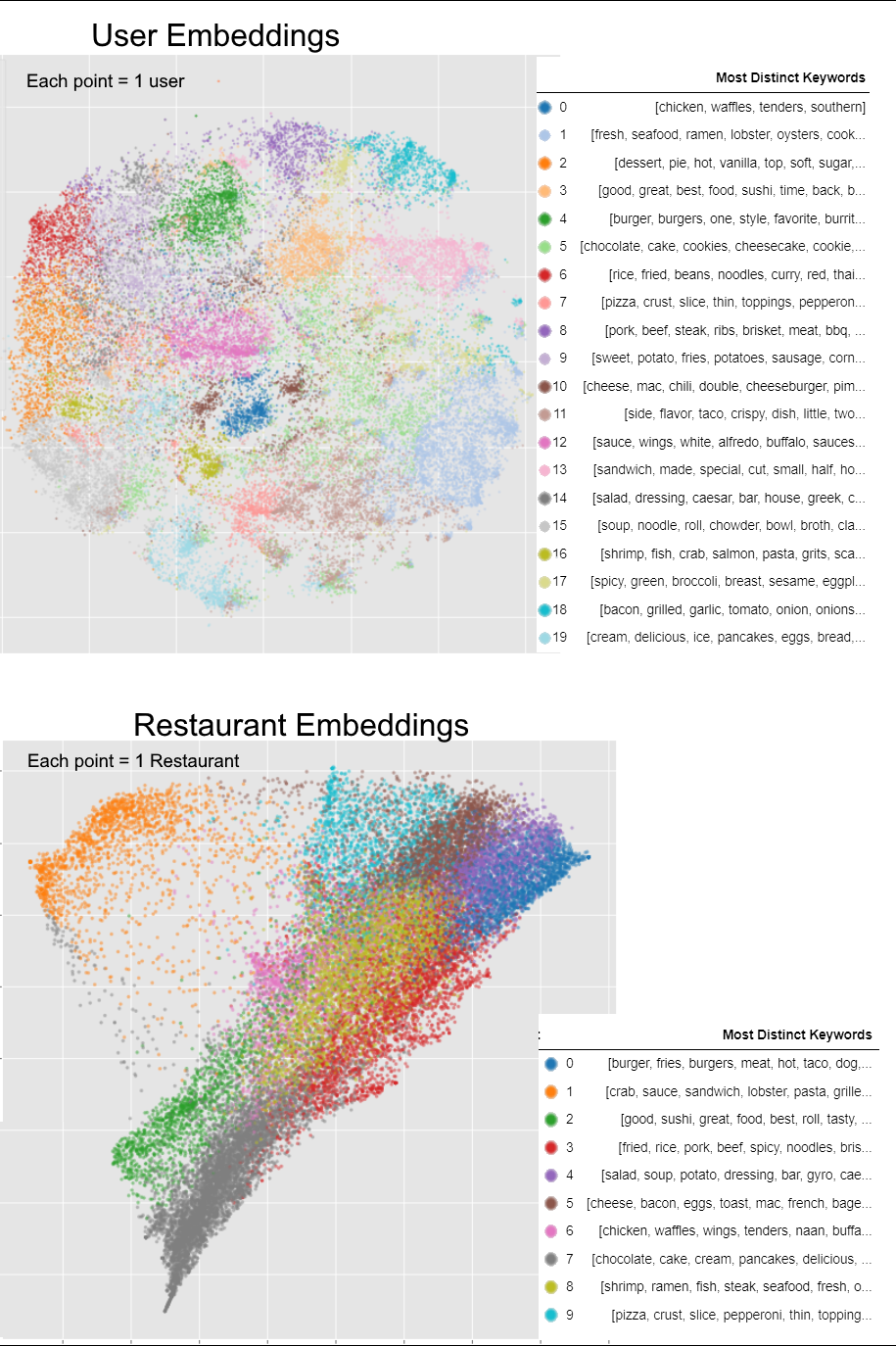
- We can recommend a user of user-group 7 (pizza-lovers), to a restaurant of restaurant-group 9 (pizzarias). Or dessert lovers (user groups 2, 5, 19) to dessert restaurants (restaurant-group 7). Or seafood-lovers (user-groups 1, 16) to seafood restaurants (restaurant-group 8).
- This independent data science project of mines explores food related datasets (unstructured text data) for prediction data analysis tasks involving customer recommendation. Two sub-projects were done.
- The 1st sub-project is building a classification model that uses the textual contents of a customer’s review to predict if they rate the restaurant favorably or not.
- The 2nd sub-project is building an auto-recommender model that can decide if a customer and a restaurant are compatible. The findings also help create segmentations of the customers and restaurants based on food vocabulary.
- This project will show:
- Data Analysis and results applicable to useful business questions on customer recommendation, such as providing insights to user demographic sub-groups.
- Succinct and Intuitive Data visualizations
- Articulately-reasoned Feature Engineering using NLP techniques (Word2Vec and Tf-Idf), to transform unstructured text data into a structured tabular format, so that it can be compatibly trained with linear models as baseline (specifically logistic regression).
- Used Tools (Everything is done in Python)
- Scikit-learn (for TfIdf Vectorizer and Logistic Regression)
- Matplotlib for visualizations
- Pandas
- NumPy
- Tensorflow and Keras
Sub-Project 1: Restaurant Rating Prediction given User Text Reviews
- For this 1st task, a basic sentiment analysis model will be made and trained to predict whether a user’s rating for a restaurant is negative or not, given the text data of their text review.
- In-depth Feature Engineering will be all that is needed to transform unstructured text data into explainable and structured, tabular data.
Data Preparation and Feature Engineering
- Preprocessing was done on the review text column like lowercasing, and replacement of non alphanumeric characters with whitespace.
- TF-IDF vectorization was done on the processed review text column, dropping NLTK’s English stop-words list. This produced a matrix with column count as the vocabulary size.
- The review rows of the new TF-IDF matrix were grouped separately by the corresponding binary rating category.
- Then within each group, the rows were collapsed with a column-wise mean (i. e. np.mean with axis = 0). This produced a new matrix that had a row count of 2 and a column count of vocabulary size.
- Do a column-wise argmax (i. e. axis = 0) on the new array, and filter only for the columns where the argmax row index corresponds to the category for bad ratings. Use these column indices and the vocabulary mapping of the saved TF-IDF vectorizer object to retrieve the words.
- The previous steps basically filtered for the words that have a stronger “belongingness” to bad reviews compared to good reviews, using TF-IDF. But now, it was decided that among these words, only 100 is needed. While all of these words have stronger relevance to bad reviews, some are stronger than others, so these words are sorted by the largest absolute difference (between the 2 rows), and the topmost 100 got picked.
- With these 100 words, and typical bag-of-words count vectorized matrix was produced upon the original reviews dataset, and serves as the input matrix to the model.
Modeling, with Class Imbalance Undersampling
- Logistic Regression was used. However, the target data had class imbalance where good ratings were over-represented. There are probably some explanations behind this (maybe users tend to be polite or optimistic). To address this, 10 models were trained separately, where each model’s training data had to under-sample the over-representative good ratings. These 10 models had each of their coefficients normalized for equal scaling, and each coefficient across the 10 models was averaged, (alongside the intercept).
Results and Evaluation
- The results on the test data showed that this prediction had a remarkable 79% accuracy in determining if a user would rate a restaurant as good or bad based on their text review;
- The confusion matrix also showed that the undersampling procedure fixed the class imbalance; had this not been done, the prediction model would have just given almost every review a good rating.
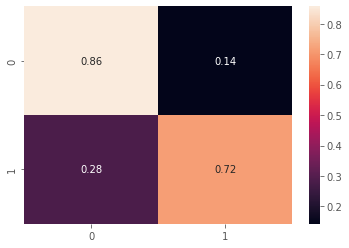
- Finally, a peek at the 20 strongest coefficients of the prediction model, and their corresponding words.
- In other words, the presence of these following words in a google review are heavily associated with a user giving a restaurant a bad rating.
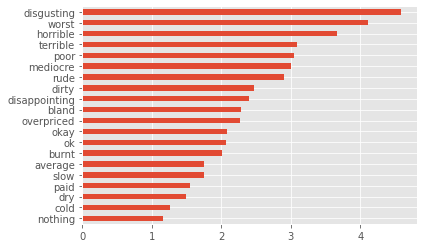
- This makes sense, as most of these words have negative connotations, and even more impressively, it manages to pick out words that aren’t just negative “emotional” words (like worst, or bland)- it also includes words that are otherwise arguably neutral but deemed negative in the context of food at a restaurant (overpriced, burnt, dry, cold)
- This demonstrates our intricate feature engineering process was successful in extracting meaningfulness from the unstructured text data of the google reviews.
Sub-Project 2: Predicting if a User will visit a Restaurant
- This 2nd task on user-restaurant determines how likely a given user would dine at a given restaurant, based on the user’s history of previosuly chosen restaurants (if available) and the restaurant’s history of customers. In other words, collaborative filtering.
- Unlike the previous task, this one will employ more advanced deep learning and pre-trained ML tools.
Overview
- The model should take a given user and a given restaurant as input, and output a value between 1 and 0 if the user will visit and eat at that restaurant (or not).
- The user and restaurant are both represented by vectors of the same dimension. These vectors are in turn the compressed summaries of all the information about a given user / restaurant.
- The vector for a user is the TF-IDF weighted centroid (i.e. the average vector) of the Word2Vec vector representations of each food-related word that showed up in all of the reviews that the user has written.
- The vector for a restaurant is the TF-IDF weighted centroid (i.e. the average vector) of the Word2Vec representations of each food-related word that showed up in all of the reviews about the restaurant.
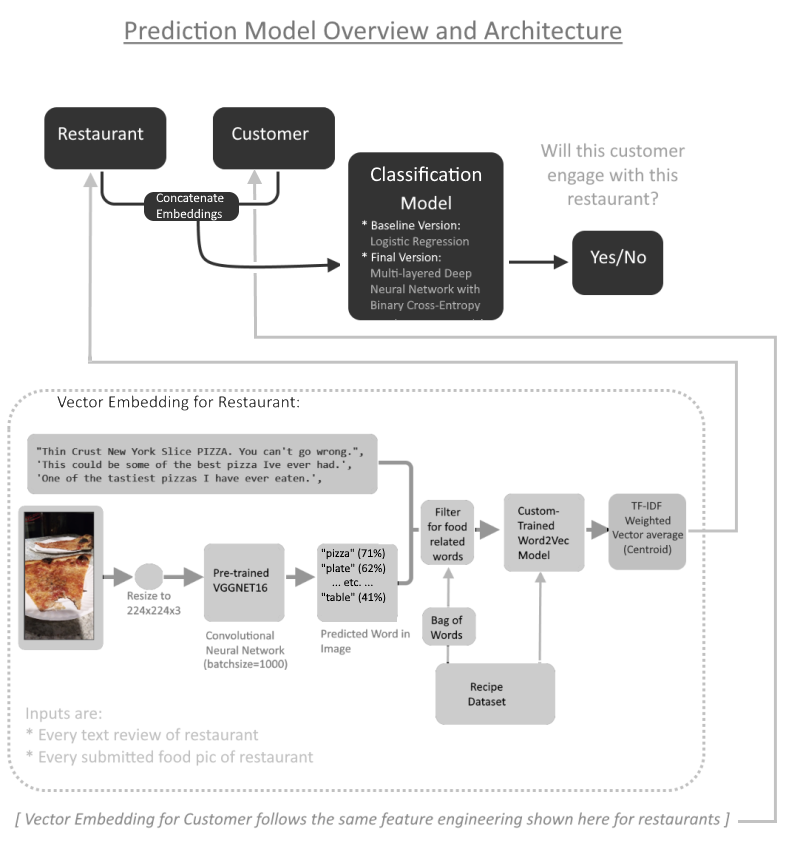
- This graph visually summarizes the model architecture. As one can see, 80% of the time is actually for the feature engineering, while the prediction model itself is merely a 20% part at the end - a binary classification that’s as simple as logistic regression (for the baseline version at least).
Word2Vec
- In order to approximately select only the food-related words, a completely separate dataset was used: a recipe dataset where one of the columns was a list of ingredients for each recipe; While it’s impossible to get a universal list of every food-related word that exists, this is sufficient enough to build a bag-of-words.
- A custom Word2vec model was then trained on this ingredients column. Because of the way the autocorrelation in the ingredients column works, the newfound embedding model should be able to capture relationships between words: words that are associated with one another, will have word2vec vectors that are close to one another.
- One of Word2Vec’s famous features is the ability to do “arithmetic” with words. For the custom food dataset vocabulary that we trained Word2Vec on, we expect things like “barbeque - july 4th + thanksgiving”, which basically asks “If July 4th is to barbeque, then Thanksgiving is to …?).”. The top leading words are related to turkey.
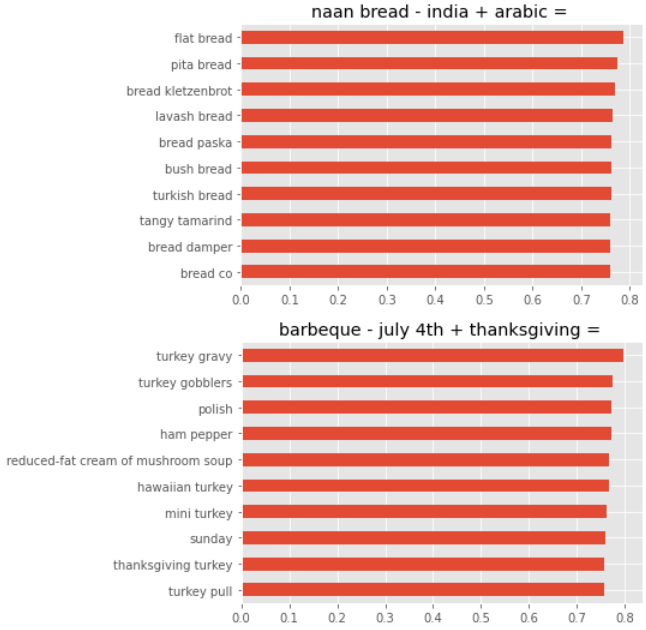
- For exploratory purposes, it’s also nice to check the word that “represents” a restaurant - which is just the word whose vector representation is closest to that restaurant’s vector.
- Sometimes, that representative word is very obvious, being a very frequently appearing word in the reviews (like pizza)

- Other times, it is a subtle word that might not even have appeared in the reviews at all. For this restaurant with only 1 review, it was deemed “mediterranean”, even though the word “mediterranean” is nowhere to be found. Only 1 word may have been all that was needed to tip it to that label - “Gyro” (a Greek dish)

- From this, each review was preprocessed, filtered of any non-alphanumeric characters, tokenized, and filtered of any words that didn’t exist in the bag-of-words.
- Then for each restaurant, all of the remaining words for each review they are associated with are turned into a Word2Vec vector using the custom-trained Word2Vec model from earlier, then re-weighted by TF-IDF, and averaged column-wise. The exact same process is done for each user.
Image Recognition with Pre-trained VGGNET16
- Some of the reviews comes with images of the food submitted by the users; this could be fed through a pre-trained VGGNET16 convolutional neural network, which then labels the object in the image, outputting the most likely possible words it might be. The words are then filtered to only get food-related words using the food vocabulary as made by the recipe dataset. These words are attached to the text review as though it was part of the review.
- For example, if an image in a review is a picture of a cupcake on a plate on a table by a window, the VGGNET16 model might output the top predictions as “cupcake”, “window”, “table”, “plate”. Assuming that the food vocabulary I created is large enough to include the word “cupcake”, then that would be the only word that will be used from the image.
- The python code accomodates this procedure, but was switched off for the baseline model since it’s quite computationally costly.
Unsupervised ML: Dividing the Restaurants and Users into Distinct Sub-groups with K-Means Clustering
- After doing this, each restaurant and each user should have its own vector representation; this can be mapped to 2D scatterplots (transformed with TSNE): each point in space on the left scatterplot is a restaurant, while on the right are users.
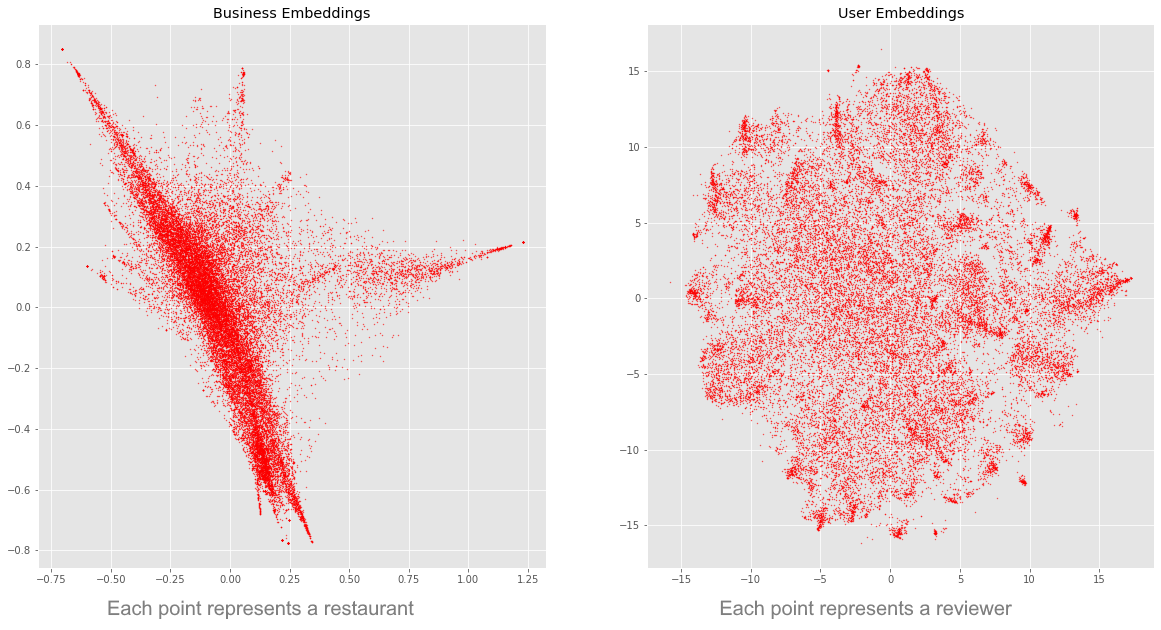
- Furthermore, it is possible to group up the vector representation using the technique of k-means clustering. I separated the restaurants into distinct sub-groups based on the textual content of the reviews written about it, and did the same for users.
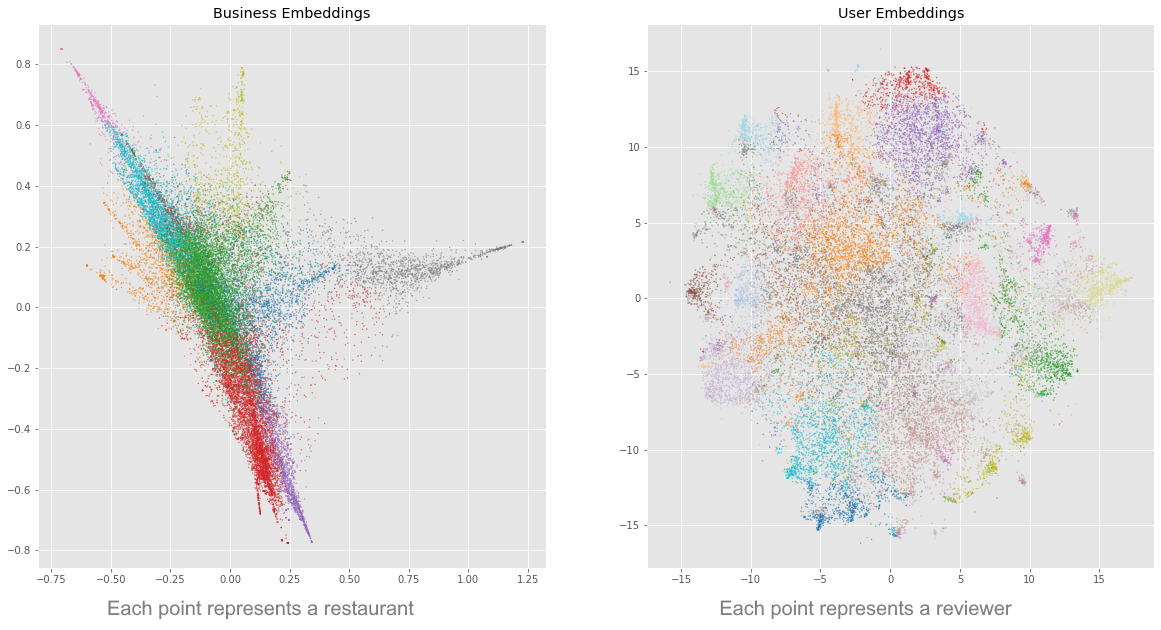
- While this is not necessary, it would be insightful to actually see if there’s any actual meaningfulness in the sub-groups that was automatically created by the K-means clustering, for restaurants and users. To do so, I extracted the “most distinctive” keywords” of each sub-group, using a method that employs TF-IDF.

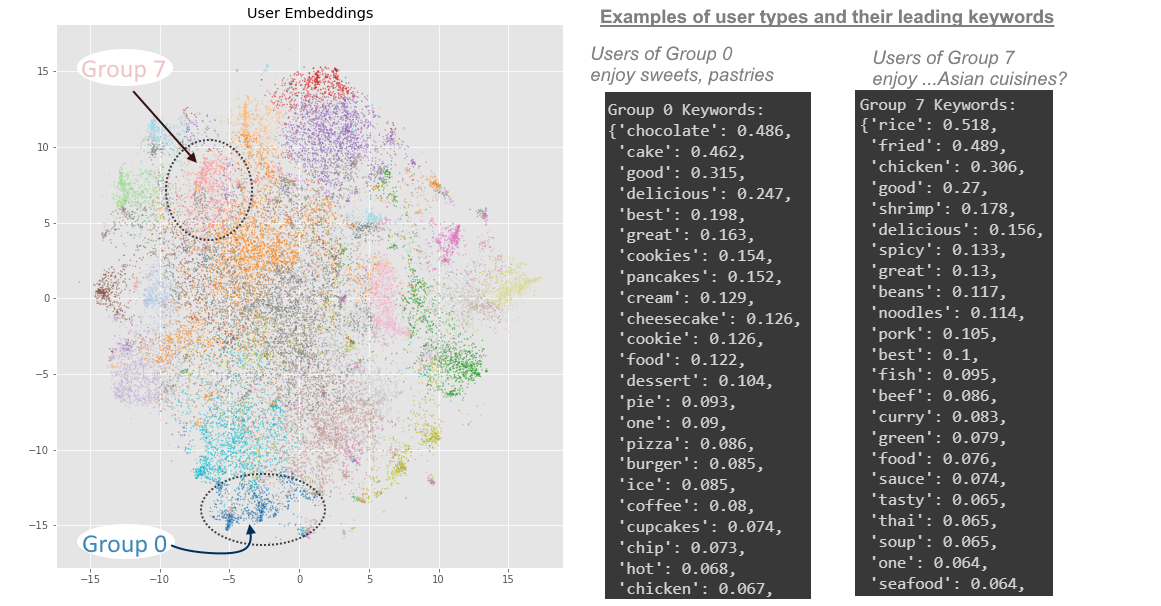
- The overarching direction of my project is to connect user sub-groups to restaurant sub-groups. For example, restaurant-group 4 tends to make desserts (sweets, confectionery, pastries), and user-group 0 tends to eat mostly desserts.
- In other words, I am grouping up restaurants by the food they serve, and grouping up the restaurant-goers by the food they review, and hoping that a one-to-one correspondence (if it even exists) becomes visible between restaurant-types and customer-types in terms of food. This would allow me to recommend the dessert-lovers (as seen above in user-group 0) to the dessert restaurants (as seen above in restaurant-group 4) …and recommend Italian food lovers to Italian restaurants, seafood-lovers to seafood restaurants, and so on.
- To see more examples of these restaurant/user “sub-groups” and their “most distinctive keywords”, scroll to the bottom half of the visualization notebook in the github repo
Prediction Modeling: Binary Classification
- Finally, the last part is to create a prediction model that answers whether or not a given user is likely to interact with a given restaurant… with the underlying data being based on the types of food that the given restaurant serves and the types of food the user has eaten at other restaurants.
- 2 different model versions will be created and trained towards the same goal of binary classification: a regular single-layered logistic regression with Sklearn; and a Multi-layered Deep Neural Network with TensorFlow
-
For this interaction problem, it is necessary to manually create “artificial, unseen” pairs; since every user-restaurant pair in the dataset is real and observed, there is no “nonexistent pair” samples to compare the observed pairs against. A sampling procedure was developed that tries to find “negative” (a.k.a. never-before-seen) combinations of users and restaurant. This of course brings into consideration an unspoken assumption that the given dataset is an extremely accurate representation of real life; in other words, I am assuming there are no cases where the artificial pairs that I created actually did exist in real life, but wasn’t recorded in the dataset.
- The final input matrix that the model will train on, will have an equal share of “real, observed” user-restaurant pairs and “artificial, unseen” user-restaurant pairs. Each row of the matrix, a user-restaurant pair, is made by normalizing both the user and restaurant vectors, and then multiplying them element-wise (which should be possible since the user and restaurant vectors have the same lengths). This is essentially cosine similarity, but before the summing-step of the dot product.
- The original way of combining information from the user and restaurant embeddings was just concatenating the 2 side-by-side, but this yielded bad accuracy.
Logistic Regression
- The baseline model will use logistic regression: in terms of metrics, it’s around 63-66% accurate in correctly determining whether or not a given user has visited a given restaurant. Its AUC score is 64%.
- For a baseline model, this score isn’t too awful, but is a good starting point open to more adjustments to the model; for example, the embedding sizes of the user and restaurants Word2Vec vector representations can be increased from 100 to 1000 dimensions.
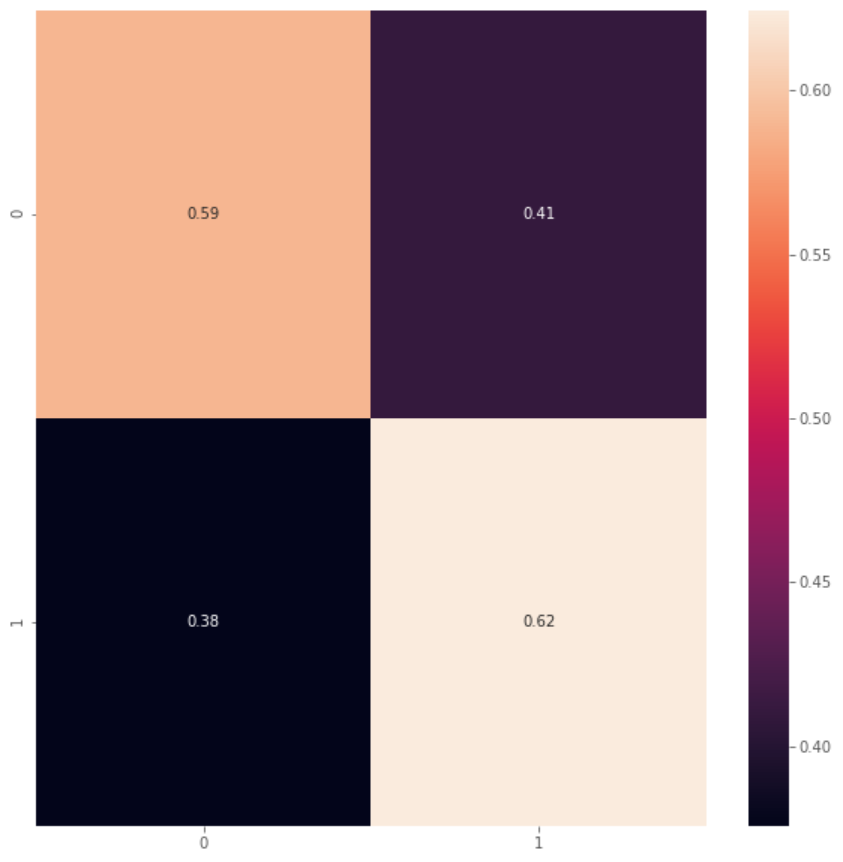
Multi-Layered Neural Network
- This model uses 3 layers (2 ReLU, 1 sigmoid), with Binary Cross Entropy Loss.
- For metrics of the Multi-Layered Neural Network as the prediction model, it is around 73% accurate in correctly determining whether or not a given user has visited a given restaurant.
- While this metric is clearly an improvement from the logistic regression, it is not far enough of a jump in improvement. At this stage, it is wise to see if using Deep Neural Networks over Logistic Regression run into diminishing returns. But one could also argue that as much as Deep Learning overuses “black-box” methods, feature explainability was abandoned a long time ago the moment Word2Vec was used, so there is likely very little to lose by using even more deep learning.

Conclusion
- Overall, this model does not yet have a procedure for never-before-seen users and restaurants.
- This model also must acknowledge several considerations:
- The dataset used is only limited to the customers who willingly and manually wrote a review for a restaurant. This model cannot be extended to the general population of more casual resaurant-goers. Thus, this model’s goal is more so whether a reviewer will review a restaurant or not.
- This dataset lacks the geo-location of the restaurants, which might be essential to this specific prediction task. Realistically, people will be unlikely to eat at a given restaurant if it is far away from their house, and logically can only eat at nearby restaurants, even if the far-away restaurant aligns better with their food preferences than their local ones. This is a glaring inadequacy of this dataset (and in turn, the tasks that we can do with it).
- Some of the techniques used in the feature engineering are outdated. For future improvements of this project, Word2Vec can be replaced with more modern NLP methods like BERT Embeddings, while VGGNET16 can be replaced with more modern CNN architecture like Resnet.
- However, the data analysis done along the way, still had useful results:
- I made a trained a Word2Vec model for food.
- I found a way to divide restaurants and customers into distinct sub-groups simply by the types of food they were eating, as seen in the scatterplot of colored groups. This type of information can still be useful as a base data in any future “spinoff” projects.